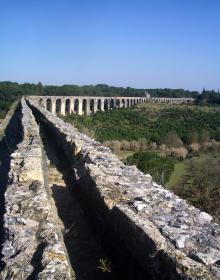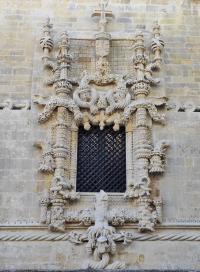- HOME
- MONUMENT
- Convent of Christ
- History
- Architecture
- Personalities
- King Afonso Henriques
- D. Gualdim Pais
- King Dinis
- King John I
- D. Lopo Dias de Sousa
- King Duarte
- Prince D. Henrique (Henry
- King John II (1455 - 1495
- King Manuel I (1469 - 152
- Diogo de Arruda
- João de Castilho
- Jorge Afonso
- Olivier de Gand
- King John III (1502 - 155
- Diogo de Torralva
- Friar Anthony of Lisbon
- Baltazar de Faria
- Filipe Terzi
- Philippine Dinasty
- King Philip II of Spain
- King John IV
- Domingos Serrão
- Queen Mary II
- Prince Fernando
- Costa Cabral
- Artisans and Artists
- Intangible Heritage
- Related Heritage
- Glossary
- VISIT OUR MONUMENT
- HERITAGE LEARNING
- TOMAR
- MONASTERIES ROUTE

Philippine Dinasty (1580-1640)
When Portugal lost its independence in 1580, Spanish King Philip II, heir to the Portuguese throne, becomes Master of the Order of Christ as a result of the Order´s master and government hereditary rights that John III had obtained from the papacy to the Portuguese crown.
On April 15, 1581, the assembly courts convened at Tomar declared Philip II of Spain as Portuguese King. He then entered Lisbon on 25 July becoming King Philip I of Portugal. He vowed to save and keep all charters, privileges, customs and freedoms held in his new Kingdom and granted by his predecessors. He remained living in Lisbon for two years, and on the death of his son, Diogo, heir to the crown, Felipe, the Prince of Asturias that would be King Philip III of Spain and II of Portugal, was sworn in as his successor at the Lisbon assembly courts of 1582.
The Convent´s Aqueduct, started by King Philip I of Portugal and completed in the reign of King Philip II, is the most outstanding work of the Philippine period. It runs for about 6 kilometres from its springs and it arrives at the earlier Joanino convent incorporating the south facade that is thus changed by the arches of the great aqueduct.
Remarkable works of this period are also the new vestibule or Royal Gate, on the north facade of the convent, the New Dormitory, in the Lodgings Cloister, the completion of the Main Cloister, the New Vestry in the Cemetery Cloister, the Baroque trace Fountain of the Main Cloister driven by water from the aqueduct, and the staircase, also of Baroque features, which connects the Castle forecourt to the Convent church yard.
From the time of King Philip III no notable work or event remained as a testimony of his time through mastering and government of the Order of Christ.
On April 15, 1581, the assembly courts convened at Tomar declared Philip II of Spain as Portuguese King. He then entered Lisbon on 25 July becoming King Philip I of Portugal. He vowed to save and keep all charters, privileges, customs and freedoms held in his new Kingdom and granted by his predecessors. He remained living in Lisbon for two years, and on the death of his son, Diogo, heir to the crown, Felipe, the Prince of Asturias that would be King Philip III of Spain and II of Portugal, was sworn in as his successor at the Lisbon assembly courts of 1582.
The Convent´s Aqueduct, started by King Philip I of Portugal and completed in the reign of King Philip II, is the most outstanding work of the Philippine period. It runs for about 6 kilometres from its springs and it arrives at the earlier Joanino convent incorporating the south facade that is thus changed by the arches of the great aqueduct.
Remarkable works of this period are also the new vestibule or Royal Gate, on the north facade of the convent, the New Dormitory, in the Lodgings Cloister, the completion of the Main Cloister, the New Vestry in the Cemetery Cloister, the Baroque trace Fountain of the Main Cloister driven by water from the aqueduct, and the staircase, also of Baroque features, which connects the Castle forecourt to the Convent church yard.
From the time of King Philip III no notable work or event remained as a testimony of his time through mastering and government of the Order of Christ.
SERVICES - ACTIVITIES




